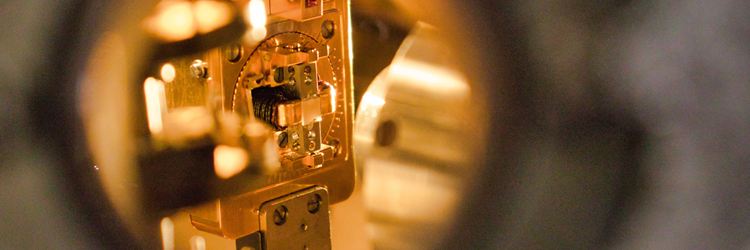

The APE High-Energy is a beamline at Elettra Synchrotron focused on the electronic and magnetic properties of surfaces and nanostructures.
The APE‐HE is one of the beamlines of Elettra Synchrotron that receives the radiation from an APPLE II undulator placed in a zig‐zag configuration. The research at APE-HE is focused on electronic and magnetic properties of nanostructures and the surface reactivity in heterogeneous catalysis.
The beamline
The beamline covers the energy interval 200‐1500 eV. The end‐station is equipped with an electron energy analyzer and a low noise system for the XAS recording in TEY mode. Recently it was designed and realized a new reactor for performing operando‐XAS at ambient pressure. The APE‐HE endstation is connected in vacuum to the NFFA‐nanoscience‐lab, NFFA‐PLD and the APE‐LE endstation.
The MBE CLUSTER
The MBE CLUSTER station placed on the beamline side is composed by 3 UHV chambers interconnected: Oxide MBE, MASK MBE (with in vacuum MOKE) and off‐line XPS station (VolPe).
This system permits the preparation of high quality strongly correlated Oxide single crystal thin films and interfaces such as ferroelectric layers and ferromagnetic manganites and their chemical, structural and magnetic characterizations.
Instrumentation:
A new cell has been realized for operating XAS spectra at ambient pressure during gas exposure. This instrument permits the study of the electronic properties of active sites during the course of the catalytic reaction. The instrument has been designed and realized at the IOM institute and is one of the few devices in the world of this kind. Thanks to this instrument (and with the scope of improving its performances) the group was awarded of a PRIN project.
Software:
Software control of all instruments has been implemented in‐house:
Future developments:
The ongoing projects involve the design and realization of a new end-station for the APE-HE beamline which will be devoted to hosting the cells for XAS at ambient pressure. The new station will give the opportunity to develop the environment for the ambient pressure experiment (e.g. by permitting the installation of UV light source for photocatalysis studies) and will smooth the alternating of UHV and ambient pressure experiments.
The first main axis of research is focused on electronic and magnetic properties of nanostructures with particular attention to the systems that present effects relevant for Spintronics application (e.g. Magnetoelectric coupling, exchange bias, proximity effect, magnetic anisotropies, etc.). From this point of view the synergy with Oxide MBE (and PLD‐NFFA) is a strategic asset permitting the preparation of state‐of‐the‐art ferromagnetic and ferroelectric thin films. A second topic is: the investigation of the catalytic reaction with SR spectroscopy in operando condition. In this context we realized an instrument to perform NEXAFS spectra at ambient pressure with which we investigate the behavior of the active site of catalyst during reaction (e.g. during methane to methanol conversion, during gas sensing by Sn-oxides, during gas adsorption from MOF’s). The overall operation and all the instrumentation developments of the APE‐HE beamline and the MBE Oxide‐MOKE‐XPS cluster facility have been implemented along the strategy and with the support of the NFFA research infrastructure projects. NFFA aims at continuously developing and operating an integrated users access infrastructure to nano‐foundry services (growth, characterization, theory, fine analysis, FAIR data management) along with APE‐LE, NFFA‐SPRINT and with partial involvement of other IOM activities (EM, MBE‐nanowires), using dedicated resources from national and European grants.
Perspectives: The experiments concerning the magnetic properties and the hybrid ferroelectric and ferromagnetic components will be performed integrating the effect of light irradiation to the system under study. At the same time the experiments on the solid/gas interface will be enriched by the study of the materials for anodes and cathodes of fuel cells.
PRIN 2019, MOSCATO, 2019-2022
MIUR‐FOE, NFFA-TRIESTE, 2016-present